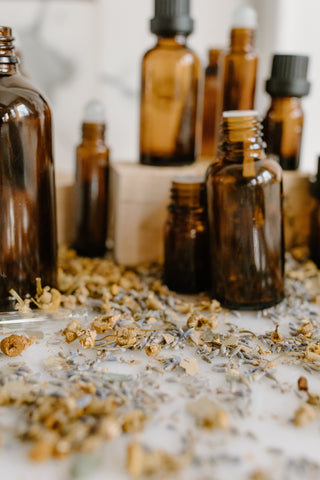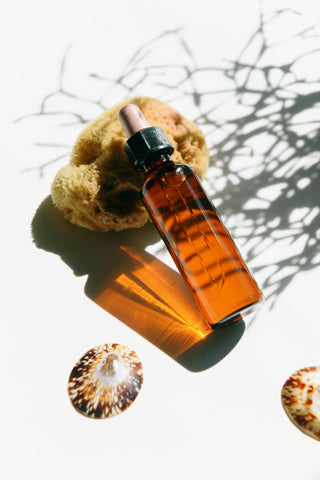By Caylie Warkentin
Nature's webs remind us of our dependency, our need, our connections, of those we nourish and those who nourish us. All this implies a mindfulness that does not happen automatically.
Rinda West

To sustain means to not only hold up, or to support, but to endure, to suffer. At least this is how the term was used in France in the 14th century before the suffix ‘able’ was tacked onto the end, an appendage that transformed an actionable verb into an adjective, an ending placing us on the sidelines. In present, the term sustainable is worn like a wool blanket, draped across packaging and practices in a veil of commitment to the planet and personal wellbeing.
As an ethos, sustainability is a non-word, too vague to be meaningful. It does not rest on legal backing or certification, and yet the propensity for brands claiming sustainable initiatives is anticipated to be worth over $50 billion dollars by 2027, with presently 50% per cent of consumers considering sustainability to be a significant factor in their purchases.
The shift towards sustainable manufacturing, packaging, and products is indicative of a larger shift in consumer attitude towards a rediscovered connection with nature and the physical and mental benefits it offers. This can be seen not only in our usage of cosmetics but in our dietary habits and lifestyle. As we spend more time disconnected from nature through physical space, we seek to regain our connection with the products we surround ourselves with, leading us to care more deeply about how these products are made, packaged and the impact they have on ourselves and our planet.
Sustainable beauty in present

In recent years the trend of healthful beauty products has overlapped with green initiatives, and beauty brands have been marketing themselves based not on the ingredients included in their products, but on the exclusion of certain ingredients, like parabens and phthalates, words that shine out like warning lights. The clean beauty movement is part of a larger trend spurred on by consumer education and mistrust of big brands, and reflects a related movement for eco-friendly practices to replace single-use products with recyclable and zero-waste alternatives.
With brands claiming different sustainable initiatives, certification has followed swiftly to legitimize the claims brands are making. Perhaps the most comprehensive form of certification is from B Corp Certification, which evaluates brands based on their social and environmental performance, legal commitments of accountability, and transparency of their claims measured against B Lab’s standards.
These credentials help consumers discern which brands are upholding the claims they are making and lessens the possibility of corporate greenwashing – the act of making something look more green than it appears.
Sustainable packaging

When thinking of excess waste, the first thing that might come to mind is packaging - after all, it’s the first thing we see when purchasing a product, and the first thing to be disposed of. An estimated 120 billion units of packaging is created by the beauty industry every year, and less than ten per cent of this waste is properly disposed of. The longevity of certain packaging is striking – think of plastic material that breaks down into microplastics that infiltrate our land and water systems. Other elements of packaging, like mirrors included in so many makeup palettes, are not recyclable.
The good news? There are many alternatives to single-use packaging, and small beauty brands are at the forefront of innovating lower-waste packaging. Post-consumer recycled material (PCR), materials made of recycled plastics and metals, make use of pre-existing used packaging. Biodegradable and compostable packaging can be disposed of and integrated back into the environment without causing harm if disposed of properly. Package-free products are also coming into popularity, like package-free solid shampoo bars and plastic-free laundry detergent. In recent years, refillable packaging has been highly sought after, and this industry only continues to grow. For beauty products, purchasing refillable inserts is a good way of minimizing waste by reusing functional exterior packaging.
Sustainable ingredients

Sustainable beauty also encompasses ingredients, which often branches into claims of clean, green, and chemical-free. The term sustainable might imply that ingredients are sourced from ‘natural’ sources, derived from nature rather than produced synthetically in a lab. Wild sourced ingredients are not without cost, though, and are finite, meaning over-consumption will inevitably end in environmental degradation.
In Cristina Montemayor’s essay The Clean Beauty Movement is Killing the Environment, she details the way in which wild harvesting of plants can threaten native species. One of the most sought-after ingredients is bakuchiol, a derivative of the Psoralea corylifolia plant, prized as a plant-based retinoid alternative. The harvesting of bakuchiol has placed pressure on the plant, already under threat from human encroachment on native habitat, and the plant has been pushed to the brink of extinction numerous times.
Not all harvested plants wreak havoc on the environment, though – if the crop is regenerative, harvested for small-batch production, and native to the environment, environmental impact can be lessened.
Synthetically produced ingredients are also a viable and efficacious alternative to wild-harvested plants. Though synthetics were once posited as being harmful, we now know through scientific and fact-based data that this doesn’t tell the full story – synthetically produced ingredients replicating naturally occurring molecules can be just as healthful and beneficial in cosmetic ingredients as their natural counterparts.
Sustainable beauty in future

If sustainability is to be defined not by its etymological roots or quantified in percentages and statistical data, it is defined by nuance. The most sustainable choices factor in not only exterior packaging and green claims but the entire process of creation from the manufacturing of the product to its disposal.
At the heart of sustainability is a sense of endurance driven out of our care for the planet and care for ourselves. It also captures a sense of necessity – to ensure that the ingredients placed on our bodies are beneficial and not harmful, that the products that promise longevity extend that same consideration to the planet.
Hope for meaningful sustainable change can feel elusory, liminal, a coherence utterly unlikely to be reached by the millions of beauty brands that exist. But as Rebecca Solnit writes in Hope in the Dark:
“To hope is to give yourself to the future - and that commitment to the future is what makes the present inhabitable." Hope is the antidote to inaction and is what will continue to drive effective sustainable initiatives.
Sources + Further Reading
https://www.acme-hardesty.com/green-cosmetics-sustainable-beauty/
https://www.voguebusiness.com/beauty/to-be-more-sustainable-beautys-biggest-companies-are-teaming-up
https://www.byrdie.com/natural-synethtic-ingredients-sustainability-4843069
https://aedit.com/aedition/guide-to-sustainability-and-recycling-beauty-products
https://www.bloomberg.com/news/articles/2021-10-12/makeup-retailers-like-sephora-double-down-on-1-6-billion-clean-beauty-boom


